‘HDR mobile computing’ is how I would neatly define the Ultrabook category. These surprisingly powerful laptops can work as efficiently as a netbook and then when you need the power, kick-in cores, turbo and other special features to give you a truly all-round solution that includes video editing, gaming and care-free desktop-style working. The Asus UX21 is one of the lightest, smallest and yet, most powerful of the Ultrabooks, at least in the Core i7 1.8Ghz version we have here. We’re impressed with what’s inside and with its weight and style but there are a couple of potential showstoppers for some people. Read-on to find out more in our detailed multimedia review of the ASUS Zenbook UX21E. Thanks ASUS Germany for the review sample.
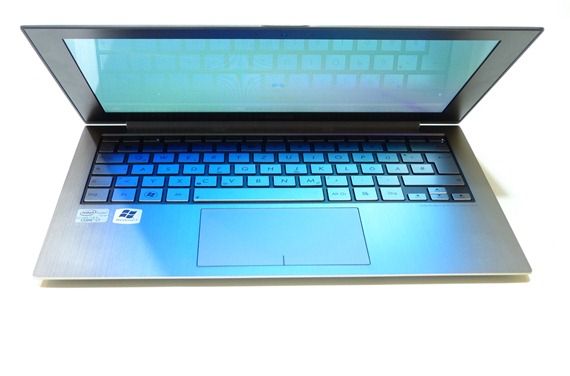
The First 5 Minutes
Of all the 2011 Ultrabooks, the ASUS UX21 and UX31 are going to be the most impressive unboxing experiences. Open the quality packaging and you’ll smile. This Ultrabook looks stunning, small and feels strong and sturdy. It’s got a clean finish on the top and bottom and even the Intel and Windows 7 stickers are in a cool grey shading. First boot should be swift (our model was pre-booted with Windows 7 and brought us into Windows 7 in 19 seconds) and welcoming with a healthy welcome sound through the built-in speakers. The screen is bright and the keypad and touchpad feel like high-quality items. The only thing you might be surprised about is the density of the UX21. The weight is fine but to the eyes it looks like it should feel a little lighter than it is due to its size. Next to a netbook it takes up a similar table area but it’s thin like no netbook that exists. The first 5 minutes is going to really make you feel good about your purchase and that’s what unboxing is all about. I think there’s a marketing term for this experience and whatever it is, ASUS got it right.
In the box you’ll find 2 port adaptors and 2 cases. One for the adaptors, one for the UX21. There’s a ‘wall blister’ lightweight 100-240v AC adaptor with long cable and removable tip included.
Live Review
As part of our review we spent 2 hours with the device while live with an audience. All the videos from the live review are available here along with a round-up of what we found out in the live session. All of it should be included in this review but just in case, take a wander over to the ASUS UX21 Live Review post.
Specifications
Although we’re dealing with a n impressive list of Core i7, 4GB RAM, 128GB SSD and 1.1KG weight, it needs to be mentioned that there’s a few trade-offs here. The Core i7 is 1.8Ghz part rather than the 2+GHz part you’ll find in slightly larger laptops and the size and weight means there isn’t a lot of room for battery. Sealed inside is a 35Wh set of cells. Full specifications along with links to news and galleries is available here.
Size comparisons
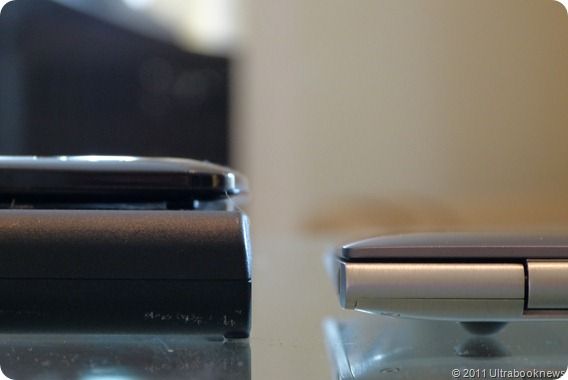
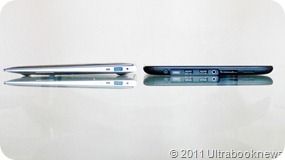
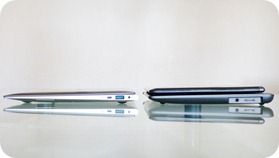
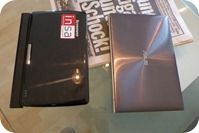
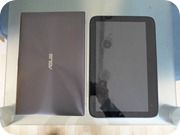
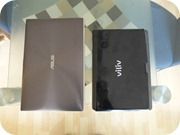
Shown above: Lenovo S103T (convertible netbook), Viliv S10 (one of the thinnest convertible netbooks), ExoPC (11.6” tablet on Intel N450 Atom CPU)
Ports and Dongles
Getting a bit more serious with the device you’ll want to know about the ports. This is an area where Ultrabooks struggle with the large ports and slots found on tradiational notebooks. Mini VGA, Micro HDMI, only 2 USB ports (one of which is a sleep-n-charge capable USB3.0 port) and a headset port (with a ‘headphone’ icon – we tested it with a headset and it worked.) You’ll need to buy a micro to HDMI cable if you want to use this on a large screen, a USB SD Card adaptor if you want to use SD cards and you’ll need to think about the adaptor cables that are included with the device.
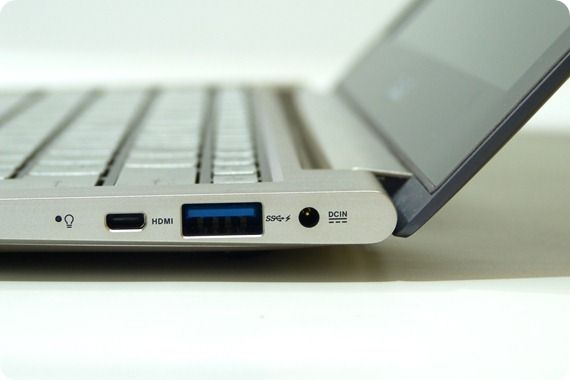
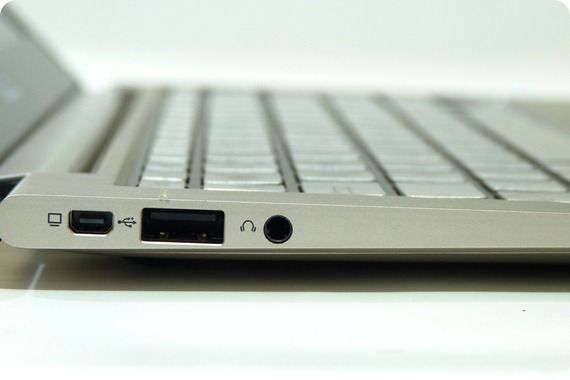
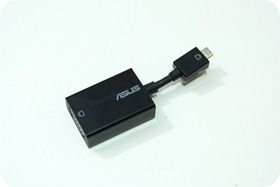
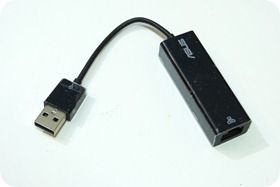
Screen
In general we have no complaints about the screen. With a good brightness, average contrast, wide viewing angles and size-matched resoution, we think it hits the mark for the average user but there’s scope for improvement in vertical viewing angles and contrast. Some might be looking for a matt screen too but you can always put a matt screen cover on a glossy screen; Something you can’t do the other way round. Brightness is excellent and although it’s not a true sunlight capable screen, it’s better than most for outdoor usage. There are easy shortcuts for color modes, brightness and backlight-off – something worth doing if you’re waiting for a video to render or playing back internet radio streams, for example. The resolution, at 1366×768 is perfect for easy-reading of default font sizes on Windows 7 at this 11.6” size and the minimum required for Windows 8 Metro user interface apps (next year.)
Keyboard / Trackpad
There’s a lot of talk about the UX-series keyboard and trackpad. Some have reported issues with both, others are 100% happy with the quality. We’re not so positive about the quality of the two items and here’s why.
The trackpad has integrated buttons for those used to the physical movement of mouse buttons but there’s no delimiter between the buttons and the pad so if your finger wanders up into the mouse control area, you affect the mouse pointer, obviously. With double-tap to click, this problem goes away. There’s a second issue we saw with two cases of touchpad lock-up. One of which required a reboot to fix. The other needed some patience before the mouse section of the trackpad came back to life. We’re running Firmware 9.1.7.0 from Sentelic and we’ve just upgrade to 9.1.7.7 to see if it fixes the lock-up issue. As the UX21 goes back to ASUS tomorrow, we’re not likely to have a conclusion on that lock-up solution.
The keyboard may have more significant issues than the trackpad for many.
We found a need to slightly change our typing style to one that requires more concentration than normal. [The author obviously uses a keyboard a lot and is a near touch-typist.] Despite that, we’re still having issues with missed keys because it’s possible to feel the key press action without registering a keypress. It leads you into thinking you don’t need as much pressure when in fact, you have to press beyond the initial ‘give’ of the keypress. We feel it’s a real issue for those that want to use the UX21 for extended typing and as it’s a mechanical issue, only the user can provide the solution by changing their typing style. [It’s possible that ASUS change their keyboard in future production runs – ideally you’ll check this out for yourself before buying.]
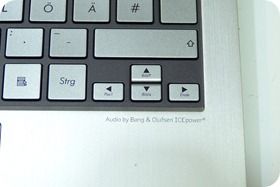
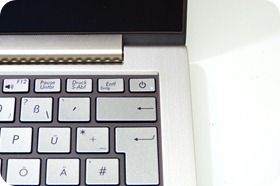
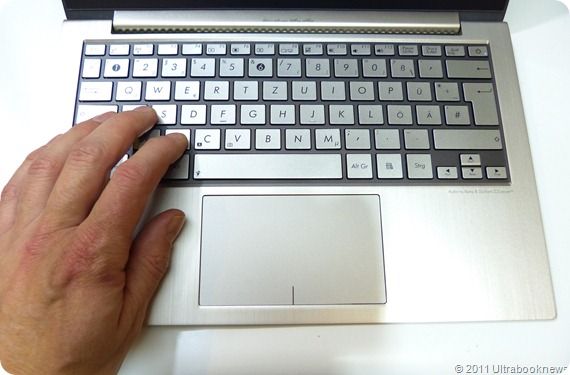
Apart from the keypress issue, we found the layout good, the integrated indicators on the power (top-right key) , WiFi and shift-lock very useful.
General Performance
The UX21E provides a very wide range of operating modes and scenarios. In battery saving mode (800Mhz) it feels like a very fast netbook and with the SSD providing fast data access and write, it still has the advantage of very quick startup times for large programs. In this mode you’ll get your normal office-based work done without any fuss, major noise and without the CPU or GPU using too much battery. Sunspider results in this mode (a relative indicator of some CPU performance) was 1012ms.
In Quiet Office mode you’ll see the CPU max-out at about 1.2Ghz. It speeds up response for web-pages, unzipping and other common scenarios to the point where you probably won’t notice any speed restriction in most scenarios.
Entertainment mode allows the graphics to run freely with a little cap on the CPU and Performance mode gives you almost everything possible from the device including Turbo Boost to 2.8Ghz where possible.
At the top end, the UX21 not only provides good CPU power through Turbo but it holds it well via powerful cooling. Things get noisy and warm but in gaming and video rendering we’ve seen 2.2Ghz being held for long periods. A lesser cooling system may not provide this level of Turbo Boost capability.
Boot, Standby
You can expect the Asus UX21 to boot in about 20 seconds, even with a big suite of software installed. More importantly, you can rely on standby to keep the device ready for action within 2 seconds of opening the lid. Apart from forced reboots, we haven’t used the power button.
There’s not much more to say about this apart from that it changes the way you use a notebook for quick-use scenarios like Wikepedia look-ups, TV, transport schedules look-up and social networking. Going back to a normal notebook boot sequence (and hard drive) is difficult.
Disk – Speed, size
We can give you detail on the 128GB SSD here by simply saying WOW! This is a fast SSD coupled with a fast controller and fast interface. Not only are the sequential read and write speed impressive but the small-block random read and writes are good too. The performance doesn’t drop off too much in battery-saving mode either.
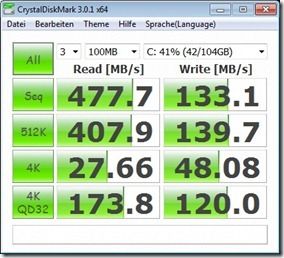
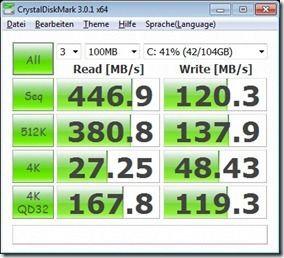
On the left, performance mode under mains power, on the right are the battery power-saving results.
Making a copy of a anything up to 1GB in size is so fast that you don’t get a chance to really see the progress bar. In practice it means that application start-up times will be as good as any high-power notebook or desktop. Starting up the latest version of Cyberlink Power Director, a relatively heavyweight program, takes just 5 seconds. Windows Media Center starts nearly instantly.
We would have liked to see a hard-disk activity light but maybe that’s the techie in us just wanting to see when Windows 7 has calmed down after booting .
Audio
Like the keyboard, the audio system has had some criticism with some complaints about mains hum on the analogue audio output. In this case we can’t find any trace of a problem here on this [EU, 220v 50hz] system. The analogue audio output is free of any noise, hum or mouse-movement interference and has great stereo separation. The built-in speakers are loud and impressive, if not full-range. Due to their positioning, they have great wide separation to them. 2-channel Digital audio output via the HDMI output was picked up and decoded without problem by our monitor. We were unable to test DTS/AC3 pass-through decoding in the time we had with the Asus UX21. Audio is provided by a Realtek unit with port sensing. The UX21 is not Wi-Di (or Wireless Audio) capable through its Atheros AR9485WG-EG adaptor. For that, you need an Intel Centrino Wifi card.
Video
The video playback capabilities of PCs have three limiting factors. CPU, video decoding hardware and software codecs. Windows 7 provides a good set of software codecs out of the box and supports most hardware video decoders. MPEG2, MPGEG4 part 2 (like Xvid, Divx) and MPEG 4 part 10 (like H.264) along with WMV of course. You’ll need to download and install codecs for other types of file.
The ASUS UX21 supports full HD (1080p) decoding in hardware and we tested it up to 30Mbps which is as high as you’ll get on most consumer video cameras. DVD and BlueRay should be no problem (Blu-Ray not tested) and you’ll find that the CPU barely moves during the process as all the work is done in dedicated silicon. For the 30Mbps H.264 file (2-channel audio) we saw 12% max CPU load.
With the good quality speakers it’s a pleasure to show family videos either on-screen or via the HDMI cable. It’s a shame there’s no Wireless Display support. As mentioned above, this requires an Intel Centrino wireless card.
The Sandy-Bridge 2nd generation core platform used in all 2011 Ultrabooks includes the Intel Quick Sync Video hardware that, through use of an Intel SDK, can provide accelerated encoding capabilities for common video file formats. It’s useful for a number of scenarios but the one that most people will probably use is format conversion so that large-format videos can be reduced to more portable versions. Using Cyberling MediaEspresso, a program that supports the Intel Quick Sync Video subsystem, we were able to convert a 50 second video from 1080p to a YouTube upload-friendly 480p in just 15 seconds – a 3x real-time conversion rate. For field reporters needing to record in full quality this provides a great way to crunch the video for upload either in quick time (newsrooms will be particularly interested in this) or over low-bandwidth connections, this is an important feature.
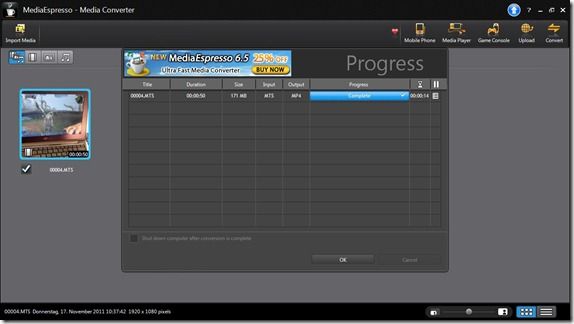
The Intel Quick-Sync video feature found on all Ultrabooks can also be used by video editing programs to speed up, significantly, the rendering process. We’ve used Cyberlink PowerDirector in the past and were pleased with its support of the Quick Sync platform and on the ASUS UX21 it showed even better results on the ASUS UX21 (Core i7) than on the Samsung Series 3 (Core i3) we tested with it last time. A quick test of Cyberlink PowerDirector 10 to sequence two 1080p 50 second videos together with a fade and down-convert to a more portable DVD-style 6Mbps format was completed in 24 seconds. That’s 4x real-time. The user interface was quick to use and previews played back without any waiting. Unless you’re doing stabilization, enhancement or other CPU-expensive processes, the ASUS UX21E will provide adequate creative video editing capability for most people, with most types of source video.
Note that the battery drain on rendering is a high 18-20W meaning you’ll only get 1.5-2hrs worth of work out of a full battery on the ASUS UX21. At 4x real-time though, it’s a lot more real rendering than other platforms with much bigger batteries. The cooling on the UX21 is unable to keep the cores cool enough for a long-term use of Intel Turbo Boost in this mode so in subsequent tests, when the device was already warm, the render rate went down quite significantly to 1-2X real time.
There’s a web-cam on the UX21 that only needs a quick highlight as being average. At VGA resolution it doesn’t really fit in with the quality of the rest of the device which is a shame. 720p video conferencing is becoming more and more common. The web cam is flanked by a built-in mic and a video-on warning light, which makes us feel a little more secure!
Gaming
There’s clearly many ways to play games on the ASUS UX21E from Flash, HTML5 through to simple native games and on to some more modern high-end games but there’s a long, long distance between what the Ultrabook platform can do and what a ‘gaming rig’ can do. Forget high-end graphics settings on modern, high-end games less than 4 years old but take a look through the back catalogue and you can find some quite impressive experiences, especially if you haven’t played a game for a while.
We start our ASUS UX21 gaming testing with Monster Dash from the Chrome app store. It ran smoothly although these windowed HTML5 games aren’t really the best of experiences. Moving on to the Intel AppUp store we took Pinball HD which played smoothly in full-screen and gave us a good experience. We tested GTR Evolution, a 2008 game, on an external 1080p monitor and it configured itself well to provide a very smooth racing experience at a lower graphics detail level. The experience on the UX21 itself was just as good. Half-Life 2 played surprisingly well under default settings in both battery and mains powered mode with frame rates over 100fps seen after a few minor tweaks. Finally, we did some detailed testing with World of Warcraft under mains and battery settings. Out of the box you can’t expect more than 30 fps in battery or mains-powered mode but with a few tweaks we saw a nice 50fps taking it out of ‘just enough’ territory.
To further demonstrate and detail the gaming capabilities of the UX21 (and Ultrabooks in general – all of the Core i7-based devices should perform very closely to what you see here) we put a video together. High-end gamers will be disappointed but I think many will be surprised just how well the Intel graphics perform.
Support Ultrabooknews and our detailed reviews.
You’ll find a Facebook ‘Like’, Twitter and Google +1 buttons below. Please take the time to promote us if you feel this review was useful. It will help us with the next Ultrabook review. Thanks!
Networking
Unfortunately we didn’t have time to do LAN tests with the USB adaptor. It provides a 10/100 connection via a USB2.0 connection on either of the USB ports. We also didn’t get time to test the BT4 module although even if we had had time, we don’t have another Bluetooth 4 capable device here to test with.
Wifi was used on a ‘G’ network at 54Mbps. The radio is only 2.4Ghz capable but b,g and n modes are supported. Wifi Direct is not supported as far as we can tell. Wi-Di is definitely not supported. Reception on our local network was above average with 3 bar availability at a two walls / 10m distance but we didn’t make any performance/distance tests. Your local environment may affect Wifi quality.
Performance Testing
Running performance test suites gives you a benchmark with which to roughly compare against other devices.
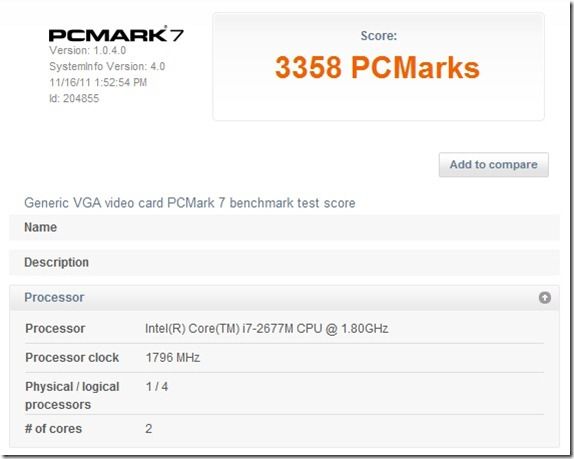
We haven’t tested any other Ultrabooks yet so we don’t have our own comparable benchmarks but if you look around you’ll find the result to be quite impressive. Be aware though that much of it could be a result of the fast SSD.
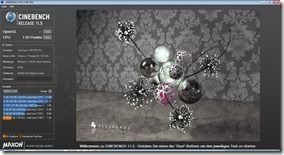
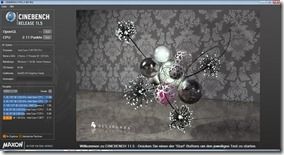
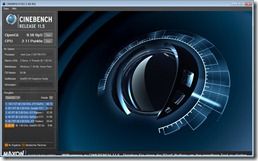
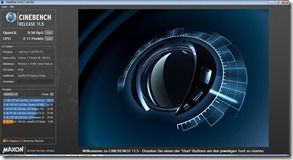
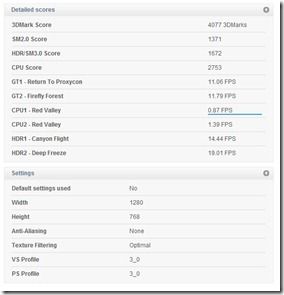
Battery Life
There’s no single battery life figure for a device that can operate in so many different scenarios. The batter drain figures range from 3.9W (the minimum we could get out of screen-off idle) through to over 25W in full-load scenarios but we’ve done a lot of tests, watched a lot of ‘perfmon’ graphs and have come up with the following for you.
- Internet Radio (battery saving mode, screen off, clean system) – Average 7W drain = 5hrs
- Web-based work. Wifi-on. Screen-on 40% – Average 8-9W drain = 4-4.5 hours
- Video playback. Wifi off. Screen on 40%. Video decoded in hardware = 11-13W drain = 3 – 3.5 hours
- Video rendering using Intel Quick Sync video, performance mode = 20W drain = 1.75 hours
- Gaming = 20-25W drain = 1.5 – 2 hours
For a Core i7 device at 1.1KG with a very small 35Wh battery in it, these figures are quite impressive.
Heat / Noise
As with battery life, there’s a wide range of operating modes. In general the thermal design is good with both low noise and high cooling extremes. For web-based working the fan stayed off for a totally silent system. Even in charging mode, the base stayed cool. We played back some hardware decoded 720p videos in battery saving mode and streamed a DVD rip with AC3 audio over our local LAN (for 30 mins in our test) and still, the fan stayed off. Obviously audio playback doesn’t tax the system either so it seems ASUS have built quite a nice home theater PC here.
There’s an important note to make about the cooling system though because Intel Turbo Boost relies on good cooling to enable overclocking. Without a good cooling system there’s very little overhead for the use of Turbo boost. Good cooling on a small system can only really be successfully achieved by moving a lot of air. Moving a lot of air makes a lot of noise. The ASUS can get noisy at high workloads but it does a good job and there’s no real fan noise, just the air. Remember we are talking about gaming, video rendering, uncompressing large files and other CPU.GPU heavy operations here and these situations will be rare for many. In our opinion, it’s an advantage to have good cooling allowing Turbo Boost operate for longer. In some situations we saw Turbo Boost settle at 2.2Ghz (the device is a nominal 1.8Ghz remember) in other situations the Turbo Boost dropped away but was back in 5 seconds when the cores were cooler. We saw that in a video rendering operation.
For most operations the UX21 is going to be silent but ASUS seem to have done a great job of cooling where necessary to get the best out of Turbo Boost. For such a tightly built system, we’re impressed. SIlent PC and HTPC fans may want to take a closer look at the UX21 if their requirements aren’t too excesive. Although we haven’t tested it, we expect the larger chassis of the UX31 to have a better thermal characteristic for silent PC usage.
Recovery Mode
ASUS provides an image on a hidden partition which can be used by pressing F9 during boot-up. It’s automated and takes a while as it reboots each time a new drive is loaded. Total time is about 25 minutes. ASUS also provide an application for snapshotting the build and saving to DVD or ISO – a useful application to use once your system is built with the required applications and modifications.
Stability
In general use we didn’t experience any stability issues apart from the touchpad lock-up issue but we did experience a serious problem that we think could be a major build fault and we highlighted it to ASUS before we posted this review.
During the live review we experienced two instant shut-downs on removing or inserting the power plug. It doesn’t happen all the time but it happens a lot. Under load, it appears to happen more than under quiet-state but the problem was definitely not a one-off for us. We’ve read about the issue being experienced for others and we feel it’s serious enough to warrant a ‘hold for further information’ before you buy. The ASUS UX21 is the kind of device you can pick up and walk around the house with; close the lid and walk to a meeting with; quickly walk across the room to show someone a funny YouTube video with but if it crashes on removal, or re-insertion of the power, it’s a serious issue. There’s no telling what long-term hard it will have to the filesystem and internal electronics.
The PR agency that sent the review device is sending it back to ASUS for testing. We hope to hear more about this soon.
Support Ultrabooknews and detailed reviews.
You’ll find a Facebook ‘Like’, Twitter and Google +1 buttons below. Please take the time to promote us if you feel this review was useful.
Other notes
- VGA adaptor tested without issues at 1440×900
- Boot time 21 seconds (with a number of games, applications installed)
- Resume time – consistently under 2 seconds
- Only one external monitor can be used at a time. This applies to all 2011 Ultrabooks
- The headphone port is a headset port
- No memory upgrade possibility on the UX21
Target Customer
The UX21 with its small profile and light weight is clearly targeted at style-concious hot-deskers. The 35Wh battery doesn’t really make it suitable for road warriors but in commuting or multi-office scenarios the UX21 would work out as a well-balanced productivity device. In theory the UX21 could be used as a family PC with an attached screen and keyboard although some additional storage may be required in this case. There’s nothing in terms of performance that would disappoint the average user unless they were looking to play the latest games or edit large amounts of home video. Given its ruggedness, it could also make a very impressive PC for students unless all-day battery life would be required. It’s not targeted at price-conscious shoppers, photographers or gamers. Given the keyboard issues, the UX21 is not recommended for those wanting to continuously input a very large amount of text; That may include some students.
Summary
The ASUS Zenbook UX21E (Core i7) proves that serious computing power can be put into a stylish, netbook-class weight. It spans a wide range of usage scenarios including the smooth, carefree experience that’s just not possible on a netbook. HD video viewing, simple HD video editing or conversions and even impressive gaming experiences can be had but in these scenarios the platform works hard, can get warm and noisy, and would drain the battery very quickly. Average battery life and general efficiency is impressive for this weight. If ASUS had produced a sightly higher quality keyboard, the UX21 would have topped the charts for a 1KG professional computing experience but they didn’t and this is something that we would advise all potential customers to test out themselves before commuting to a purchase. For a phase 1 Ultrabook, it’s impressive and exciting to think what happens in round 2 in mid-late 2012.
Images
You can find a large gallery of ASUS UX21 images in the UX21 gallery hosted over at UMPCPortal.
Support Ultrabooknews and detailed reviews.
You’ll find a Facebook ‘Like’, Twitter and Google +1 buttons below. Please take the time to promote us if you feel this review was useful.

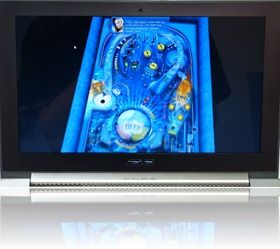
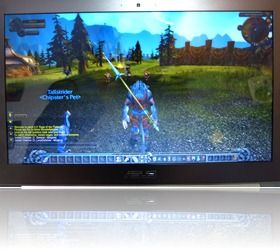
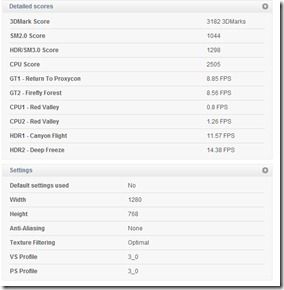










Nice review.
As I mentioned earlier, really looking forward to Asus response relating to the stability issues.
Is this ultrabooknews.com or UX21news.com???
Don’t take this the wrong way, but ever since they sent you that sample that’s basically all you write about. I also have to question how impartial you are since only Asus has given you a free laptop.
trust me, this site is neutral and fair. Chippy is a great guy. You cannot blame him if other brands are too slow at giving him review units or even launchnig them in the first place.
Try to understand that this blog is free and he has to bear all the cost of running it and finding review units. It is not that easy.
Chippy, maybe also, you need to fill your site woth fillers ie with daily news and deals like liliputing as currently, it gets updated infrequently. Anyway, thanks for all the hardwork you put in. Your site is so good that you even got loads of fans all the way from Asia.
Chippy, Once again another in-depth review.
I have always liked your long-term testing back from the UMPCPortal days, the live reviews are always entertaining and informative.
@al I understand your point, but to be fair, its not Steve’s fault if none of the other models have been offered to him for testing, Chippy can’t run out and buy every model just for our benefit. On that note, if any manufacturers are reading this site, please remember that this is the same Chippy/Steve that runs Carrypad, UMPCPortal etc. Please send him some review devices, the best way to gain sales traction is to get the early adopters on board, give out review devices and let the pro-bloggers get the word out.
Once again Steve, doing a great job.
PS I got my S3 about 2 days ago, and early impressions are pretty good. This weekend is family time but sometime during the week I’ll get into some real testing.
“HDR Mobile Computing” is a FANTASTIC way to put it and it is in THIS light that the ULV value prop looks it’s best. (I still think the pricing is off, which becomes immediately apparent as soon as you compare experience and price outside of the Intel space, but it definitely is an area that Intel until VERY recently with the Tegra 3 release had all to themselves.) The ARM “BIG, little” and “LITTLE, big” strategy provide an even larger difference from the low-end CPU perf but high efficiency and high-end CPU perf but low efficiency scenarios, at a much MUCH more attractive price, though.
If someone has a solution for running x86 or x64 apps on Windows 8 ARM, Intel’s going to be in a lot of pain in a hurry. (Compare the form factor, battery life, AND cost between a Tegra 3-based ASUS EEE PAD Transformer Prime and a Samsung 9 “Slate” running Intel ULV CPUs -or the ASUS Intel Core ULV slate, or really ANY Intel-based “slate” tablet against any of the Tegra 3 tablets about to be released.) These new ARM CPUs are going to put a hurting on Intel’s ultra high margin Ultrabooks AND Tablets.
It will be good for consumers as Intel will really have to start focusing on mobility AND they’ll have to cut their profit margins quite heftily in a hurry but Intel has MONTHS before the screws start to be turned.
The Ultrabook and Intel ULV strategy looks GREAT in a vacuum, as soon as you factor in the ARM competition it’s a really scary future for them. (From a market share, profit, and earnings perspective anyway.)
Adam
There is no doubt that ARM cpus will become the market leader and may even overtake Intel cpus. Once we are able to run Windows 8 on ARM devices, Intel is going down hill.
Really simple. Majority of people just want longer battery life as opposed to processing power. Most people do their cpu intensive tasks at home, primarily on their powerful desktop or notebook.
Intel fails to realise that the majority of users use their tablets, netbooks or notebooks just to surf the Internet and light office stuff.
I don’t see Intel failing if people who use ARM based devices also have Intel based notebooks/desktops.
Nope, the fact is Intel is actively trying to get into the mobile market and are developing their technology towards providing low power solutions that can start competing with ARM solutions.
Intel just doesn’t have a good solution yet, which is a far cry from failing to realize anything, but they’re only a year or two away from changing that status.
Similarly ARM is advancing and starting to develop higher power solutions but it’s just as hard, if not harder, for them to develop higher power solutions as it is for Intel on developing lower power solutions.
ARM wasn’t designed for high power solutions and is still years away from going 64bit, they only recently introduced the necessary architecture but it’ll be about 2 years before they’ll even have a sample system available.
While the amount of performance people need on the go is on the rise. Things like augmented reality, video editing, photography, console level gaming, among other factors are all increasing the performance people are demanding from their mobile devices.
People also have to work and many want to be creative. All of which tends to also demand more performance than the typical mobile device is even close to providing.
Services like what Citrix provides only exist because people need more than what’s available now.
So both Intel and ARM are racing to provide solutions that can provide both the performance and power efficiency consumers are starting to demand.
The competition is really only starting to begin and we’re a long way off from seeing who will ultimately dominate.
Meaning everything is still in play and that for now ARM and Intel only dominate where they have traditionally dominated and neither will start dominating the other for a few more years at least.
We may just see the dominance of both start to weaken a little in the meantime as they leverage their individual advantages against each other and find which niche markets are best suited for each as they compete in a ever increasing range of applications.
I’m going to keep this as simple as possible…
Intel is alot like Apple, inflated profit margins, cash hoarding, innovating as slowly as possible. Ultimately they will suffer the same fate as Apple in the next 5 – 10 years, niche marketshare & drastically reduced profits. The ONLY reason Intel has been so successful over this last decade is because they hitched their wagon to a monopolistic giant like MS with Windows. MS’s reign is over & so is Intel’s.
The profit margins of the future are not in hardware or even software, it’s services. Google, Amazon, Facebook know this while old world companies like Apple/MS/Intel are doing everything they can to stop it.
It’s way too early to underestimate either MS or Intel. Since they’re both still very powerful companies and both are making large strides to really compete and just rely on past advantages.
There was just a lack of real competition before but that’s changing and so are those companies.
While profits from services are not going to replace profits for hardware for the vast majority of companies. Especially when most of those services are being provided by just a few companies.
Besides many of those services are provided by software, which MS is also involved with and they even provide some. It’s just a different business model than what purely hardware companies follow.
Oh, Adam here trying to inflate ARMH’s share price again.
(BTW, I checked, and its at $26, which is pretty overinflated)
UX21: 9W with web browsing. Out of that, about 2W is screen. So 7W on system.
How much out of the 7W is CPU?
Answer: Not much
One of the most efficient Netbook in the world, the Asus 1005PE, uses 4.5-5W. That’s with a CPU with a TDP of 2.5W + NM10’s TDP of 1.5W, making it a total of 3.5W. It also uses a pitifully slow platter disc technology running at only 5400RPM. System memory is 1GB, a quarter of the UX21!
The UX21’s CPU is a 17W part and HM65 chipset uses 3.9W, a 20.9W combination, yet the web browsing difference is only 2.5W.
What about on CPU demanding apps? Oh wait, the ARM device can’t really do stuff because its too slow.
Have you also heard Windows-on-ARM will need emulation to run x86? Why wouldn’t you get an Android instead then?
Only an idiot would come up with a statement like Adam is trying to inflate ARM’s share price.
Adam says: (From a market share, profit, and earnings perspective anyway.)
That’s pretty much a shareholder talk. I suggest you look at existing product before saying things again.
nice cover up. appreaciate it a lot. but .. i personally need the 8-10 hours off cable my netbooks deliver on the go. btw without a second bag to carry for adapters and stuff. SD card reader is an absolute must
How’s Asus with providing long term driver support? Do I have to hunt down drivers from each component manufacturer?
I’m very interested in this. I’m coming from Thinkpads where Lenovo continued IBM’s great driver support and updates.
I would say Asus is okay with driver support. They provide BIOS and Driver updates on their support site for each model they have ever sold.
Though update versions tend to stop once everything is stable but the ones posted should remain available years after they stop making the model.
Aside from Nvidia and AMD drivers it’s pretty rare to need to hunt down newer drivers for a Asus system.
Thanks for the info. Do you or anyone else here know if Asus has provided new drivers when a new version of Windows comes out?
If the model is still being actively sold and it actually needs newer drivers then yes.
Like when Asus provided updates for Windows 7 for their Eee PC line, the older discontinued SSD models were by an large ignored but the more recent hard drive models were mostly supported. So usually within reasonable period they will provide support.
Mind there are also popular user community message boards where people provide tech support for each other.
The Eee User Forum is presently down but it for example had knowledgeable users that provided everything from modding how-to’s to where to get the latest drivers.
So keep an eye out for one for Zenbook users if you decide to go with Asus.
I picked up a UX31 from Best Buy a couple of days ago, and so far, I love it. The laptop is fast; though it’s probably because I mainly use CULV laptops that are at least two years old.
However, it is not without defects. The main problem when I first turned it on was that the touchpad did not work properly; thankfully, I knew of the problem before hand (from reviews on the web) and immediately updated the touchpad driver. It’s working defect free since.
The other, not so curable, problem is the keyboard. The keys are much shallower than what I am use to, and it certainly takes time to adjust. Also, while the touchpad is large, it is nonetheless easy to accidentally touch it and misplace the cursor when typing.
All in all, aside from the keyboard gripes, the UX31 is an impressive piece of hardware. The 1600×900 screen and the fast SSD were the main reasons I went for the UX31 instead of the UX21, even though I generally despise ultraportables larger than 12.1″. The battery life is good for ~6 hours browsing, which is another plus over the UX21. The $100 off sticker price from Best Buy put this laptop cheaper than the Lenovo U300s that’s coming out next month and sealed the deal for me.
Disclaimer:
I am not an Asus representative, nor am I affiliated with chippy. I just needed a new laptop for college and didn’t want a macbook (too expensive for the same specs).
Thanks for the thoughts. Owner feedback is just as important as reviews.
Eagerly waiting for your views on U300s, Chippy… With each passing day and each additional review, I am more and more inclining towards lenovo considering my business needs – good keyboard, good battery life, enough performance and right sized SSD…
No worries about the lack of sd card slot?
I am not a pro photographer and have used the sd card slot in my present laptop in the last 3 years maybe once or twice! add to the fact that sony memory sticks dont work with normal sd card slots and one can always use a camera USB cable to transfer the pics, that I dont really care about this feature! its more of a nuisance for me as I always tend to lose the dummy card in the slot! :)
what I care more about is the lack of backlit keyboard and maybe a full size VGA and ethernet port, but I guess if I am going to buy a 1st gen ultrabook, I’ll have to settle for the least evil! ;) I’ll buy some port attachments for the time being, I guess…
Ok. I guess as someone who regularly uses a camera with sd card, it’s a lot more important to me. Sdxc is something i want for my work in 2012
Anyone have a guess to when SDXC cards will achieve the 832+ Mbps speeds? Would be nice for transferring HD videos. I’m not a professional or anything, I’m just impatient when transferring my personal videos.
Basically, keep a look out for when the planned SD 4.0 specification takes over and becomes the new standard.
SDXC cards based on the SD 3.0 specification has pretty much the same limitations as SDHC.
Though that means those SDXC cards can pretty easily work with any SDHC card reader, but the new SD 4.0 specification changes the electrical pin outs to provide the higher theoretical max speed. So you’ll need both SD 4.0 compliant readers and cards to get those high speeds.
Also the performance of the card itself needs to be able to take advantage of the higher IO speed potential.
So it’s going to take a year or two before you can really start expecting those kinds of speeds.
Thanks everyone for your comments. I’m pushing to get the Z830 next week. Stay tuned.
Hey Chip! First of all, many thanks for the professionally performed live stream test session! I have a question regarding the SSD in the UX models. There is no doubt that the A-Data SSD recieves much better WEI scores (7,9!) than the Sandisc version (5.9). Can I as a potential buyer by any means know what actual SDD is in the computer before I buy it?
I’ve got a UX21 and am getting the intermittent shutdown issue when unplugging the power.
Did you ever hear back from Asus regarding this?
yeah, i totally agree with you.http://www.jogosdahotwheels.com
Writing your article is very complete and good, you are clever enough to package it, but I took a long time to read it
I have a macbook air, which is faster when compared to Zenbook UX21E ultrabook, and what if for gaming
Hey there,
I agree with your review, although I do not experience the sudden shutdown when adaptor cable is (dis)connected to/from the machine.
I am experiencing another challeng with the keyboad, that couldn’t find an answer on the web.
There are moment (Every day) when out of the blue I can’t type in a field in Internet Explorer. The keyboard works if I type an internet webpage but if I am to type in the search field it is completely locked up. Only when restarting I can type normally again.
Did you experience that also? Maybe you can help solving this mistery. Thanks!
That’s good news! Thanks for the feedback.
I get shutdown issue when plugging in or unplugging the adapter. asus are not experts in designing laptops
I strayed your place a few weeks back and I absolutely can not get enough!
Please keep writing!
Hi I am no way a tech person however I have a big problem with this Asus zenbook that I bought recently. It worked fine for a couple days but then all of a sudden (I was using it unplugged) it shut down, I thought the battery died but I was so sure it should have battery, since it stays plugged in at all times. So I went back to put the cord (charge) on, pressed the power button and the zenbook started. I left it there for a while for it to charge then took it inside again but it would not turn on at all. So now, it works when the cord is plugged in but when I unplug, immediately shuts down… dies… I searched online for what could be the problem and I saw that some ux31 have similar problems. I don’t know, could you help ? What could be the problem? Is it just my zenbook or is this normal? Thank you!
The model is: Asus zenbook UX32VD-V1G
China Electronics Manufacturing Services Industry Forum,
to “OEM and EMS: Selection and Management” becasue it
is theme, concerns the context of the global electronics manufacturing industry development trends, in particular
the internationalization of China’s electronic information enterprises along the way of cross-border collaboration and value chain collaboration, including OEM and EMS interaction.
If your beloved features a fascination with vanilla or cherry, many
brands carry flavored nicotine, so that they not only have the nicotine, however
it tastes good too. Using the use of the kit we can comprehend on the directions being performed within this kit.